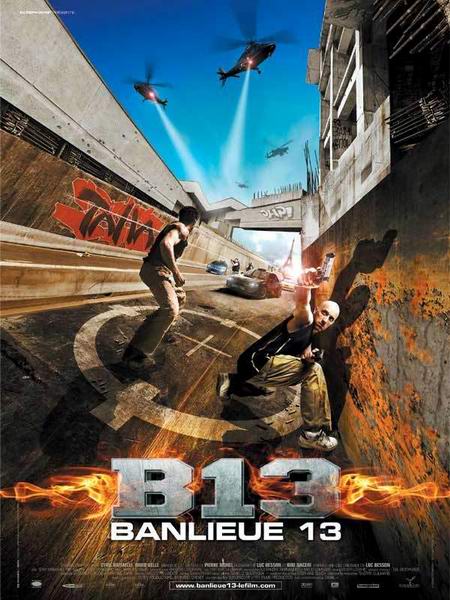跑酷是一项街头疾走极限运动,把整个城市当作一个大训练场,一切围墙、屋顶都成为可以攀爬、翻越的对象,特别是废弃的房屋,更适合飞檐走壁似的速降、跳升和飞跃……跑酷的动作追求的是出其不意的效果,往往超出了常人的想象。法国电影Banlieue 13(暴力街区)即是展示跑酷街头文化,主角戴维•贝尔是跑酷运动的创始人之一。
金今 选 万熙卿 译
What’s Parkour?
Parkour is a physical activity that is difficult to categorize. It is often mis-categorized as a sport or an extreme sport; however, parkour has no set of rules, team work, formal hierarchy, or competitiveness. Most experienced traceurs think of parkour as a discipline closer to martial arts. According to David Belle, “the physical aspect of parkour is getting over all the obstacles in your path as you would in an emergency. You want to move in such a way, with any movement, as to help you gain the most ground on someone or something, whether escaping from it or chasing toward it.” Thus, when faced with a hostile confrontation with a person, one will be able to speak, fight, or flee. As martial arts are a form of training for the fight, parkour is a form of training for the flight. Because of its unique nature, it is often said that parkour is in its own category.
什么是跑酷?
跑酷是一项难以归类的身体活动。它常被错误归类为一项运动或极限运动,但跑酷并没有固定规则、没有团队合作、没有正式等级,也没有竞争性。大多数有经验的跑酷者认为跑酷与武术类似。戴维•贝尔说:“跑酷就身体动作上来说就是越过路上的一切障碍,就像你有紧急情况一样。你想以这种方式运动,只要能更多地跃过某个人或事物,就像逃离或追赶它们一样,任何动作都可以。”这样,当我们与别人发生敌对冲突时,我们可以说服、可以搏斗,也可以逃离。武术是一种战斗训练,而跑酷则教人逃跑。由于其独特本质,跑酷通常被认为是自成一派的。
A characteristic of parkour is efficiency. Practitioners move not only as rapidly as they can, but also in the most direct and efficient way possible; a characteristic that distinguishes it from the similar practice of freerunning, which places more emphasis on freedom of movement, such as acrobatics. Efficiency also involves avoiding injuries, short and long-term, part of why parkour’s unofficial motto is to be and to last. Those who are skilled at this activity normally have an extremely keen spatial awareness.
跑酷的一大特点是效率。练习者不仅要尽快移动,也要尽可能采用最直接最高效的方式;这也是跑酷和其他类似的自由奔跑不同的地方,后者像杂技一样更加注重动作的自由。同时效率也包括避免受到短期和长期伤害,这也是为什么跑酷的非官方格言中提到:存在并持续。通常善于跑酷运动的人空间感也非常强。
Par for the Kourse
Le parkour is a recently coined French term (related to the verb parcourir, “to run over or through”), sometimes referred to by the initials PK. The activity (and its name) were created by David Belle, Sebastien Foucan, and a group of their friends when they were teenagers living in the Paris suburb of Lisses in the late 1980s. Belle’s father had been a soldier in Vietnam, and his training included navigating obstacle courses. Belle picked up many of the moves—and the philosophy behind them—from his father and, along with his friends, developed them into an art form.
越过障碍
Le parkour是最近才新造的一个法语词,从动词parcourir(跨越或穿过)而来,有时以首字母缩写PK出现。这项活动(及其名字)都由戴维•贝尔、塞巴斯蒂安•福冈和几个朋友于20世纪80年代末创立,当时这群青少年都住在巴黎郊区利斯。贝尔的父亲曾是越战士兵,而他所接受的训练中就包括障碍课程。贝尔从父亲身上借鉴了许多动作(及其所蕴含的哲学),与朋友们一起将其发展成一种艺术形式。
Parkour combines elements of running, gymnastics, dance, and martial arts into a breathtaking—and sometimes dangerous—way of moving from place to place (typically in an urban setting). The general idea is to move quickly and gracefully, treating whatever objects you come across as elements in an obstacle course. Buildings, walls, handrails, rocks, and anything else that people normally walk around become mere props or gymnastic apparatuses that you “flow” over, across, or through. The only real rule is that you should not move backwards, but given any number of ways to get from point A to point B, the objective is to do so with as much efficiency and style as possible.
跑酷将跑步、体操、舞蹈和武术元素相结合,融合成一种刺激(有时也很危险)的活动形式(场地通常选在城市)。这项运动的理念是迅速而优雅地、从一处到另一处的移动,将你遇到的所有物体都当成障碍课中的元素。建筑物、墙壁、栏杆、岩石等所有人们通常绕开的物体成为了道具或体操器械,你可以流畅地越过、跨越或穿过。这项运动真正唯一的规则就是你不能向后移动,但因为从A点到B点有许多方法,目标就是以最高效、最优雅的方式到达终点。
Unlike skateboarding (which parkour resembles in some ways), the only equipment required for parkour is a good pair of shoes. Participants, who call themselves traceurs, wear no protective gear but typically invest a great deal of time in training and preparation in order to execute the necessary moves safely. The first thing any participant learns is how to cushion the impact of a jump (or fall) by rolling. Although parkour is ultimately about clever improvisation rather than choreographed moves, there are a couple dozen or so standard maneuvers that almost all traceurs learn—including several techniques for getting over tall walls.
与滑板不同(跑酷某些方面与滑板类似),跑酷所需的唯一工具就是一双好鞋。参与者将自己称为跑酷者,他们不戴任何保护装置,但通常都花许多时间进行训练和准备,以便安全地做出必要的动作。任何参与者所学的第一件事就是如何通过翻滚缓冲跳跃(或摔倒)所带来的冲击。虽然归根结底,跑酷体现的是巧妙的即兴发挥而非提前设计的动作,但几乎每一个跑酷者都会学习二十几个标准动作,如翻越高墙的若干技巧。
Some traceurs participate merely for the fun or the challenge, but others treat parkour as a more serious art, similar to some martial arts. As a philosophy, the movements metaphorically represent becoming one with your environment, learning how to overcome obstacles without effort, and finding creative paths—all things with practical value outside the sport.
有的跑酷者参与这一活动只为乐趣或挑战,但有的跑酷者则将其视为一门严肃的艺术,与武术相仿。作为一种哲学,这些运动象征我们与环境融为一体,学会不费力气地跨越障碍和独辟蹊径——这些都对运动之外的现实生活有实用价值。
Running Free
Even though parkour has reached a significant level of international popularity only in the past three years or so, there is already an offshoot sport that has led to a great deal of bitterness and division among parkour proponents. Co-founder Sebastien Foucan, in a 2003 BBC documentary called “Jump London,” referred to the sport as “free-running”—apparently as a simple attempt at an English translation—and that term caught on in the media. However, parkour purists feel that the direction in which Foucan has taken the activity is entirely different (in both execution and philosophy) from what he and Belle had originally developed—and that what is now known as free-running should not be confused with “true” parkour (which Belle still promotes).
自由奔跑
即使跑酷只在最近两三年才在国际上流行,但目前已经有一种分支运动在跑酷支持者中引起了反感与分歧。跑酷的发起人之一塞巴斯蒂安•福冈在2003年一部名为《伦敦跳跃》的BBC记录片中将其称为“free-running(自由奔跑)”——明显是尝试简单翻译成英语,而这一词汇在媒体上大为盛行。但是,跑酷纯化论者觉得福冈为跑酷指出的方向(无论在方式还是哲学上)与他和贝尔最初的设想大相径庭,因此目前所谓的自由奔跑不应与(贝尔一直提倡的)“真正”跑酷相混淆。
The biggest difference has to do with theatrics. Free-running involves a lot of trick moves, particularly mid-air flips and spins. Because these moves are merely showy, not economical—they don’t actually help the participant to get from place to place—they’re considered contrary to the nature of parkour. A free-runner may also move backwards in order to make a move as flashy as possible.
两者最大的不同在于观赏效果。自由奔跑包括许多技巧动作,尤其是半空弹跳与旋转。由于这些动作只是为了好看,而不高效——它们并不能真正帮助参与者从一点移动到另一点——因此它们被认为与跑酷的本质相悖。此外,自由奔跑者也可以后退,以令动作尽可能好看。
But it’s not simply a matter of differing styles. Clothing manufacturers are capitalizing on the growing interest in parkour and free-running by introducing special shoes, designer clothing, and other gear; free-running competitions are also beginning to appear. This commercialization is at odds with the idea of parkour as being a discipline of great simplicity, elegance, and subtlety. Traceurs fear that their art form is being cheapened and degraded.
但这不仅仅是风格的不同。越来越多人对跑酷和自由奔跑产生兴趣,服装商抓住商机,推出了特制鞋子、设计师服装与其他装备;自由奔跑竞赛也开始出现。这些商业化元素与跑酷作为一项简约、高雅、巧妙运动的理念有所出入。跑酷者也担心他们的艺术形式正变得廉价庸俗。
Whatever else can be said about parkour (or free-running), it certainly requires athletic ability. Participants must be in shape—and more than a little daring. Unsurprisingly, the vast majority of participants are male, and most are in their teens or twenties. Although I have every respect for the beauty and grace of parkour, I think I’ll be sticking with t’ai chi myself. All things being equal, I prefer not to be bouncing off the walls.
总之,无论跑酷(或自由奔跑)究竟为何,它都要求运动能力。参与者必须具有良好的身体状况——而且还要有胆识。不难想象,大多数参与者都是男性,而且大多是十几岁或二十几岁的年轻人。虽然我非常欣赏跑酷的优雅与美感,但我想我还是继续练习太极吧。虽然运动无差别,我还是不太愿意从墙上一跃而下。
in its own category 自成一派,独立构成一个类别
offshoot sport 分支运动
at odds with 与……相悖
